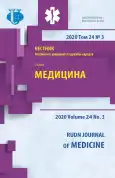Immunopathogenetic features and prognostic criteria for severe hemorrhagic fever with renal syndrome
- 作者: Ivanov M.F1, Balmasova I.P2, Zhestkov A.V1
-
隶属关系:
- Samara State Medical University
- A.I. Yevdokimov Moscow State University of Medicine and Dentistry
- 期: 卷 24, 编号 3 (2020)
- 页面: 207-217
- 栏目: IMMUNOLOGY
- URL: https://journal-vniispk.ru/2313-0245/article/view/319597
- DOI: https://doi.org/10.22363/2313-0245-2020-24-3-207-217
- ID: 319597
如何引用文章
全文:
详细
Aim. Assessment of the features of cellular immunological mechanisms at the early stage of HFRS of varying severity and development of prognostic criteria for the risk of a severe course of the infectious process. Materials and methods. An immunological blood test (flow cytofluorimetry method) was performed in 12 patients with severe HFRS and 53 patients with moderate course in the dynamics of the disease. Statistical data processing was performed based on the SPSS software package. Results. At the initial stages of HFRS, immunological features of the severe course of the disease were established in the form of a higher content of T-helper and regulatory T-cells in the blood and a reduced number of CTL, including their activated pool. Based on these changes, an immunological prognostic coefficient of HFRS was developed, which allows determining the risk of severe course in the early days (febrile period) of the disease with high prognostic accuracy. Conclusion. The results obtained allowed us to identify previously unknown features of the immune process at the initial stages of HFRS development, which allowed us to propose a new approach to predicting the severe course of the disease.
作者简介
M. Ivanov
Samara State Medical University
编辑信件的主要联系方式.
Email: iri.balm@mail.ru
Samara, Russia
I. Balmasova
A.I. Yevdokimov Moscow State University of Medicine and Dentistry
Email: iri.balm@mail.ru
Moscow, Russia
A. Zhestkov
Samara State Medical University
Email: iri.balm@mail.ru
Samara, Russia
参考
- Valishin D.A., Murzabayeva R.T., Galimov R.R., Shestakova I.V. Hemorrhagic fever with renal syndrome in adults: clinical recommendations. Moscow: The non-profit partnership “National Scientific Society of Infectious Disease”; 2014. (in Russ).
- Conner SD, Schmid SL. Regulated portals of entry into the cells. Nature. 2003;422(6927):37—44. doi: 10.1038/nature01451 3. Guterres A., de Oliveira C.R., Fernandes J., de Lemos R.S.E. The mystery of the phylogeographic structural pattern in rodent-borne hantaviruses. Phylogenetics and Molecular Evolution.2019;146:35—43. doi: 10.1016/j.ympev.2019.03.020
- Hunafina D.H., Galieva A.T, Shaykhullin A.R. Hemorrhagic fever with renal syndrome. Modern Epidemiology.Medical Almanac. 2009;(2):154—156. (In Russ).
- Mitrofanova N.N., Melnikov V.L., Zolina N.F., Skorokhodova E.D. Analysis of clinical and epidemiological and epizootic features of the incidence of hemorrhagic fever with renal syndrome in the Penza region. Izvestia of highereducation institutions. Volga region. Medical science. 2009;3(11):109—116. (in Russ).
- Alekhin E.K., Kamilov F.H, Hunifina D.H. Hemorrhagic fever with renal syndrome. Bashkortostan Medical Gazette. 2013;(5):24—31. (in Russ).
- Morozov V.G., Ishmukhametov A.A., Dzagurova T.K., Tkachenko E.A. Clinical features of hemorrhagic fever with renal syndrome in Russia. Infectious diseases. 2017;(5):156—161. (in Russ).
- Jonsson C.B., Figueiredo L.T., Vapalahti O. A global perspective on hantavirus ecology, epidemiology, and disease. Clinical Microbiology Reviews. 2010;23:412—441. doi: 10.1128/ CMR.00062—09
- Goeijenbier M., Wagenaar J., Goris M., Martina B. Rodentborne hemorrhagic fevers: under-recognized, widely spread and preventable — epidemiology, diagnostics and treatment. Critical Reviews in Microbiology. 2013;39(1):26—42. doi: 10.3109/1040841X.2012.686481
- Pensiero M.N., Sharefkin J.B., Dieffenbach C.W., Hay J. Hantaan virus infection of human endothelial cells. Journal of Virology. 1992;66(10):5929—5936. doi: 10.1128/jvi.66.10.5929— 5936.1992
- Krautkrаmer E., Grouls S., Stein N., Reiser J., Zeiler M. Pathogenic old world hantaviruses infect renal glomerular and tubular cells and induce disassembling of cell-to-cell contacts. Journal of Virology. 2011;85(19):9811—9823. doi: 10.1128/JVI.00568—11
- Manigold T., Vial P. Human hantavirus infections: epidemiology, clinical features, pathogenesis and immunology. Schweizerische medizinische Wochenschrift. 2014;144:13937—13955. doi: 10.4414/smw.2014.13937
- Jiang H., Du H., Wang L.M., Wang P.Z. Hemorrhagic fever with renal syndrome: pathogenesis and clinical picture. Frontiers in Cellular and Infection Microbiology. 2916;6:1—14. doi: 10.3389/fcimb.2016.0000
- Gorbunova, E.E., Gavrilovskaya I.N., Pepini T., Mackow E.R. VEGFR2 and Src kinase inhibitors suppress Andes Virusinduced endothelial cell permeability. Journal of Virology. 2011;85(5):2296—2303. doi: 10.1128/JVI.02319—10
- Yu Z., Zhou N., Li A., Chen J., Chen H., He C., et al. Performance assessment of the SAPS II and SOFA scoring systems in Hanta virus Hemorrhagic Fever with Renal Syndrome. International Journal of Infectious Diseases. 2017;63:88—94. doi: 10.1016/j. ijid.2017.08.003
- Murphy K., Travers P., Walport M., editors. Janeway’s Immunobiology. 7nd ed. New York: Garland Science, 2011.
- Zhou X., Obuchowski N., McClish D. Statistical Methods in Diagnostic Medicine. New York: John Wiley & Sons, 2002.
- Yarilin A.A. Immunology. Moscow: GEOTAR Media. 2910. (in Russ).
- Rouse B.T., Sehrawat S. Immunity and immunopathology to viruses: what decides the outcome? Nature Reviews Immunology. 2010;10(7):514—526. doi: 10.1938/nri2802
- Terajima M., Ennis F.A. T cells and pathogenesis of hantavirus cardiopulmonary syndrome and hemorrhagic fever renal syndrome. Viruses. 2011;3(7):1059—1073. doi: 10.3390/v3071059
- Lindgren T., Ahlm C., Mohamed N., Evander N., Ljunggren H-G., Bjorkstrom N.K. Longitudinal analysis of the human T cell response during acute hantavirus infection. Journal of Virology. 2011;85(19):10252—10260. doi: 10.1128/JVI.05548—11
- Xie M., Dong Y., Zhou Y., Ren X. Levels of HTNV-specific CD8+T lymphocytes in PBMC from the patients with hemorrhagic fever with renal syndrome. Internal and Emergency Medicine. 2013;8(6):503—508. doi: 10.1007/s11739—011—0633—4
- Mustonen J., Helin H., Pietila K., Brummer-Korvenkontio M., Hedman K., Vaheri A., et al. Renal biopsy findings and clinicopathologic correlations in nephropathia epidemica. Clinical Nephrology. 1994;41(3):121—126.
- Shimizu K., Yoshimatsu K., Taruishi M., Tsuda Y., Arikawa J. Involvement of CD8+ T cells in the development of renal hemorrhage in a mouse model of hemorrhagic fever with renal syndrome. Archives of Virology. 2018;163(6):1577—1584. doi: 10.1007/s00705—018—3786-x
- Walsh K.B., Lanier L.L., Lane T.E. NKG2D receptor signaling enhances cytolytic activity by virus-specific CD8+ T cells: evidence for a protective role in virus-induced encephalitis. Journal of Virology. 2008;82(6):3031—3044. doi: 10.1128/ JVI.02033—07
- Sepiashvili R.I., Balmasova I.P. Natural killer cells and their receptors specific to MHC—I. Immunology. 2007;27(1):46—51. (in Russ).
- Lee H.M., Bautista J.L., Hsieh C.S. Thymic and peripheral differentiation of regulatory T cells. Advаnces of Immunology. 2011;112:25—71. doi: 10.1016/B978—0—12—387827— 4.00002—4
- Gernoux G., Wilson J.M., Mueller C. Regulatory and Exhausted T Cell Responses to AAV Capsid. Human Gene Therapy. 2017;28(4):338—349. doi: 10.1089/hum.2017.022
补充文件









